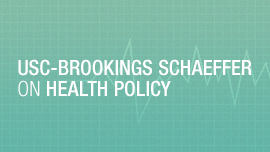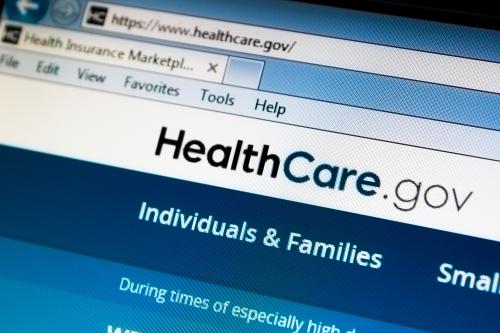This analysis is part of the USC-Brookings Schaeffer Initiative for Health Policy, which is a partnership between Economic Studies at Brookings and the University of Southern California Schaeffer Center for Health Policy & Economics. The Initiative aims to inform the national health care debate with rigorous, evidence-based analysis leading to practical recommendations using the collaborative strengths of USC and Brookings.
On November 10, the Supreme Court will hear oral argument in California v. Texas, the case in which the Trump Administration and a group of Attorneys General are challenging the constitutionality of the Affordable Care Act (ACA). If the Court strikes down the ACA in its entirety, 20 million people would lose health insurance, a variety of protections for people with pre-existing conditions would be eliminated, and an extensive set of policies affecting Medicare, Medicaid, prescriptions drugs, and other parts of the health care system would be reversed. Significant attention has been paid to the policy changes that elimination of the ACA would bring when fully implemented, but there has been more limited analysis of how health care stakeholders would cope with the sudden elimination of myriad ACA provisions in the short-term. This piece considers some of the major changes (outside the private insurance market) that would follow in the wake of Supreme Court decision eliminating the ACA and concludes that implementation is likely to be quite chaotic. While Congress could in theory ameliorate some of this chaos by quickly enacting legislation, the political trajectory of the ACA to-date does little to inspire confidence that such action would be forthcoming.
Figure 1 summarizes some of the questions that would drive uncertainty, and each of these issues is described in more detail below.
 Payment Paralysis in Medicare
Payment Paralysis in Medicare
The ACA made many changes to Medicare, generally designed to reduce unnecessary spending and improve quality of care. Those new rules are fully “baked in” to Medicare’s policies for making $800 billion in annual payments. In many instances turning off these ACA provisions would not be straightforward and would require the federal government to conduct a careful legal analysis to understand what the statute requires once the ACA provision is removed. This undertaking would be particularly complex in instances where Congress has passed legislation since 2010 that either amended or presupposed the existence of an ACA provision. It would often raise novel questions of statutory interpretation, which would likely spur additional litigation given the financial stakes involved. These problems would play out in a range of concrete settings:
- Health care providers and health insurers would face tremendous uncertainty in payments. The ACA made changes to how traditional Medicare pays virtually every category of health care provider, including hospitals, physicians, skilled nursing facilities, and many others, as well as major changes to how Medicare pays private Medicare Advantage plans. Reverting Medicare’s payment rules to a pre-ACA state would require revisiting dozens or even hundreds of policy choices the agency has made since 2010, which would likely take months or years. It might be particularly difficult to determine how Medicare should make payments to physicians since the 2015 Medicare Access and CHIP Reauthorization Act made significant changes to how Medicare pays physicians presupposed the existence of a number of ACA policies. It is unclear how CMS would make payments to providers and insurers while this process was ongoing, as it would face a choice between failing to make timely payments or making payments inconsistent with the law.
- Re-opening the Medicare “donut hole” would be chaotic for insurance companies, drug manufacturers, pharmacies – and consumers. The ACA closed the Medicare Part D “donut hole.” In doing so, it required drug manufacturers to offer discounts for certain prescriptions to plans and changed the cost-sharing plans could charge enrollees. In the aftermath of a decision to eliminate the ACA, those manufacturer discounts might immediately end, and it would be unclear what beneficiaries in a newly reopened donut hole should be charged when filling prescriptions. Nor would it be clear how to interpret many existing contracts that assumed ACA policy was in effect. The agency would also need to determine how to interpret a 2018 law that made modifications to this ACA provision, which could generate additional litigation.
- Health care systems that have invested in Accountable Care Organizations would face significant additional uncertainty. Accountable Care Organizations (ACOs) deliver care for about a quarter of Medicare beneficiaries, but all existing ACO payment models derive from the ACA. ACOs have made significant investments in redesigning care on the assumption that they could receive incentive payments if they met certain standards for the quality and efficiency of the care they delivered. The federal government might attempt to resurrect some aspects of ACO models under non-ACA authorities, but its success is likely to be limited, and the scope of any new program will be quite uncertain as policy is developed, likely for years. There would also be considerable uncertainty about how ACOs that had already signed contracts with CMS would be treated if the legal authority undergirding those agreements vanished.
- Medicare’s authority for a variety of other demonstrations and quality improvement projects would be eliminated, disrupting all the payment streams impacted by those projects. As just one example, the Innovation Center’s Comprehensive Primary Care Initiative (one of about 50 active Innovation Center projects), has more than 3000 participating providers across the country. As with ACO payment models, federal agencies might be able to resurrect portions of these initiatives using non-ACA authorities but doing so would be complex and time consuming. In the meantime, many of the payment changes bound up in these complex projects would need to be undone, impacting a wide variety of types of health care providers in uncertain ways.
- The Medicare Hospital Insurance Trust Fund would face insolvency far sooner, and there would be significant uncertainty about when. Elimination of the ACA would eliminate taxes on high income household’s investment earnings that support the Medicare Hospital Insurance Trust Fund and require Medicare to pay more to insurance companies and providers, accelerating the insolvency of the trust fund, already projected for 2024. Some of these changes could also be retroactive, with insurance companies, providers, and high-income taxpayers seeking compensation (through the agencies, or through the courts) for past years. Therefore, the magnitude of the near-term impact on the Trust Fund is difficult to predict and might be affected by subsequent litigation.
Major Disruptions to Medicaid Operations
The ACA also made a wide variety of changes to Medicaid, a program which covers 75 million people and whose importance has grown during the COVID-19 pandemic. Striking down the ACA would eliminate the Medicaid expansion, which would be a complex undertaking, and require states, providers, and beneficiaries to adapt to dozens of other changes in the program:
- Unwinding Medicaid expansion would be chaotic, would require record federal ability to address state requests, and could leave states on the hook for billions of dollars in spending. It is difficult to overstate how unprecedented it would be for the Supreme Court to strike down a program that serves 13 million people and spends $90 billion per year. Many of those 13 million beneficiaries are in active treatment for health care conditions, and all of them have coverage that is authorized in state policy documents, approved by the federal government, and largely financed with federal resources.
In the absence of federal funding, states will need to make decisions about the future of eligibility, and they will be making those decisions in an already difficult budget climate. State legislatures may need to reconvene, and the 39 states with expansions would need to file State Plan Amendments, waiver amendments, or new waivers with the federal government. As state and federal officials worked through this unusual process to unwind expansion, it is unclear if individuals would continue to have coverage and if providers would continue to be paid while changes were pending – and how the federal government would contribute.
- States would be unable to accurately determine Medicaid eligibility, and rules for new applications and renewals would be unclear. The ACA changed the rules that Medicaid uses to determine eligibility for most categories of beneficiaries, not just the expansion population, and these changes are now integrated into state eligibility systems. As a result, states would need to update their technology – which could take years – in order to properly determine eligibility for anyone in the affected eligibility categories. In the interim, it is not clear what rules would govern the 2 million new applications and millions more renewals that state Medicaid agencies must process every month, and Medicaid agencies could be penalized under federal or state law for eligibility mistakes and delays.
- Families receiving Medicaid Home and Community Based Services (HCBS) would not know if their supports would continue. Hundreds of thousands of Medicaid beneficiaries receive home- and community-based services (rather than care in a nursing home) through various waivers and other programs authorized under the ACA. Many of the programs might ultimately be reconstituted under other Medicaid authorities, but that would be time-consuming, and it might be unlawful for states to continue pay for these services through Medicaid while seeking approval. This would be a major source of uncertainty for states, home care agencies and other services providers, and the families and beneficiaries that receive this care.
- Medicaid managed care contracts may need to be repriced or rebid. Forty states operate their Medicaid programs through contracts with Medicaid managed care organizations, under contracts that go through a lengthy development and state procurement process and are approved by the federal government. The terms of those contracts incorporate features of existing Medicaid law, including expansion. Rewriting the contacts to account for the changes brought by elimination of the ACA could require new state procurement process, creating further uncertainty and burden across the Medicaid program.
Sources of Uncertainty in Other Programs
Across the health care sector, payers, providers manufacturers and other organizations would face uncertainty on a range of important questions particular to their programs. Some of those issues include:
- The status of approved biosimilar drugs would be unclear. The ACA authorized the approval of biosimilars. New approvals would immediately cease, and the status of the 28 biosimilars currently approved would be uncertain. Manufacturers of the approved products would not know if it was legal to continue making their products, pharmacies would not know if they could legally dispense them, and patients would not know if they would continue to have access to them in place of higher-priced brand name biologics. Moreover, further litigation on this question seems likely, extending the period of uncertainty.
- The future of many Indian Health Service (IHS) programs, especially related to mental health and substance use, would be unclear. The ACA permanently reauthorized the Indian Health Care Improvement Act, which supports the IHS, and created a variety of new programs. For example, much of the existing IHS infrastructure for treating mental health and substance use needs is supported by ACA authorities, and it is unclear how service delivery might have to change without ACA authorities.
- Critical access hospitals and other safety net providers would face short-term uncertainty about the prices they pay for prescription drugs. The ACA made critical-access hospitals, stand-alone cancer hospitals, sole community hospitals, and rural referral centers eligible for lower drug prices through the 340B program; striking down the ACA would end those discounts. Given the need for rulemaking and the complexity of the prescription drug supply chain, unwinding this policy will be difficult, cause significant short-term uncertainty and higher long-term prices.
The Brookings Institution is committed to quality, independence, and impact.
We are supported by a diverse array of funders. In line with our values and policies, each Brookings publication represents the sole views of its author(s).








Commentary
A Supreme Court decision to strike down the ACA would create chaos in the health care system
October 13, 2020